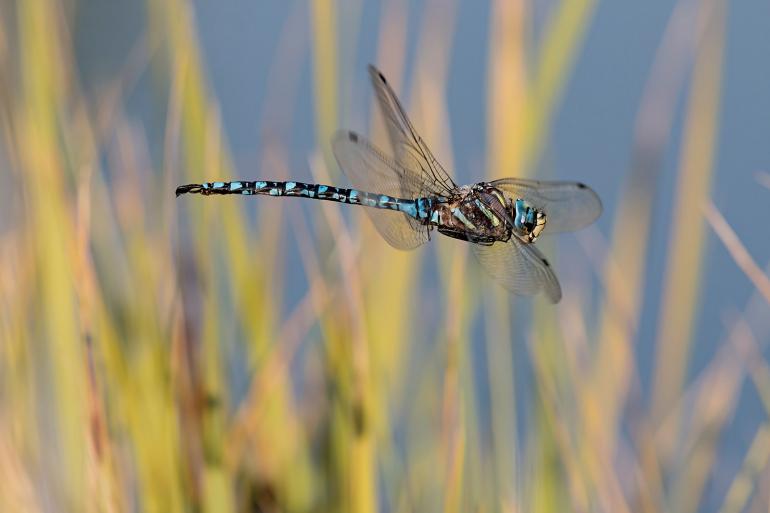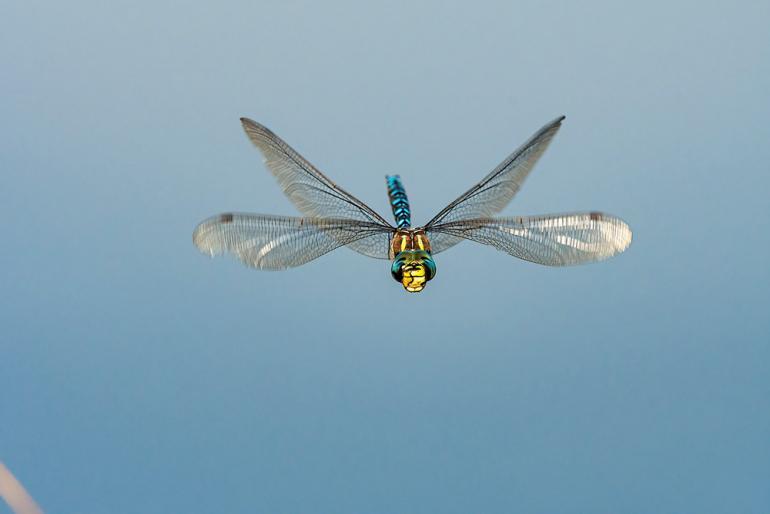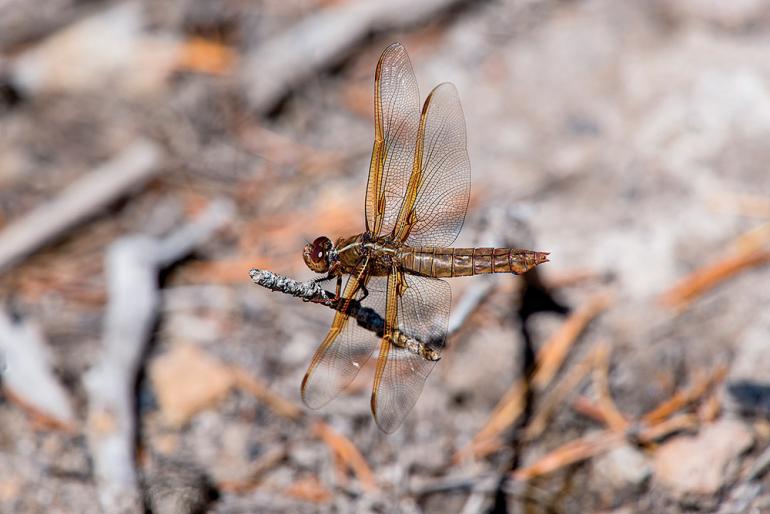Enter the Dragon
All about Montana's most prolific predator.
The most efficient predator in southwest Montana isn’t the grizzly bear, wolf, or mountain lion. It doesn’t have huge claws or fearsome fangs. Its body isn’t covered by fur or feathers, and it most certainly is not well camouflaged. No, this hunter weighs less than an ounce, has six legs, four wings, and is often a brilliant iridescent color. Yet the dragonfly may well have the highest success rate of any predator, with most studies showing that prey capture occurs in 90 to 97% of attempts. Compare that with wolves who are successful in only about 15% of hunting attempts. Even mountain lions, hunting by surprise in dense cover, are thought to succeed in only about eight out of ten tries.
A closer look at the dragonfly will reveal what makes this small insect such a fearsome hunter. Among the oldest flying insects, dragonflies first appeared almost 300 million years ago, predating the dinosaurs. They’ve had a very long time to perfect their flying and hunting skills.
There are currently over 5,000 species of dragonflies, and they are present on all continents except Antarctica. The smallest have wingspans of about three quarters of an inch, while the largest has a wingspan over six inches. There are 59 species known to occur in Montana, with the largest having wingspans of about four inches.
"Large dragonflies can reach 30mph in flight and fly in six directions"
Dragonflies belong to the order Odonata, from the Greek odontos, meaning toothed one. Although they don’t have teeth like we might normally associate with a carnivore, they do have powerful serrated mandibles used to hold and crush prey.
Life Cycle
A dragonfly begins life as an egg, which may be laid inside plant tissues or directly in the water. Eggs hatch into aquatic nymphs, the form in which a dragonfly will spend the majority of its life. This larval stage lasts only a few months for smaller species, but can extend over five years for larger species. As hunters, the nymphs are as accomplished beneath the water as their adult forms are in the air. They can expel water through gills in the rectum, giving them a form of jet propulsion when chasing prey. The nymphs have a hinged, toothed mouthpart called a labium that extends forward and rapidly retracts, capturing and pulling prey to their mouths. Voracious feeders, they will eat almost anything they can capture, including insect larvae, bloodworms, tadpoles, and even small fish.
Dragonflies undergo an incomplete metamorphosis. They do not have a pupal stage; the adult emerges directly from the nymphal phase. When ready to become an adult, the nymph makes its way to the surface, generally at night, and begins to breathe air. It crawls out of the water onto a reed or other plant, molts its outer skin, and emerges as an adult dragonfly. At this point the dragonfly is not long for the world; depending on the species, they will live anywhere from only a few weeks to almost two years.
Aerial Aces
Dragonflies are perhaps the most accomplished fliers in the insect world. This is in large part due to the unique muscles that operate their wings. In most insects, wings are indirectly operated by muscles attached to the thorax. When these muscles contract, the entire thorax flexes, causing the wings to move. This is like trying to flex your shoulder blades by taking a deep breath—it’s more efficient than it sounds, but it doesn’t give most flying insects great maneuverability. A dragonfly’s wing muscles, however, are not attached to the thorax, but directly to the hinged base of the wing. And while the fore and hind wings of most four-winged insects are coupled (meaning they move together), each of a dragonfly’s four wings has its own set of muscles and can be operated independently. This gives dragonflies an ability to change direction and speed that far exceeds that of most other insects.
Large dragonflies can reach 30mph in flight and fly in six directions: left, right, up, down, forward and backward. They can also hover in place for as long as a minute. You might think that this would require the wings to beat at an insanely rapid pace, yet a dragonfly’s wingbeat is a relatively modest 30 beats per second. Mosquitos, by contrast, beat their wings as fast as 500 times per second, and bees, over 200. Rather than wing speed, the keys to the dragonfly’s flight are its wing structure, direct flight muscles, and its ability to operate each wing independently. This type of flight does have a downside, however: it requires a huge amount of energy. To fuel this demand, a dragonfly will eat 20 percent or more of its bodyweight daily. For the smiling Paddle Tailed Darner (Aeshna palmate), that’s the equivalent of about 80 mosquitos!
Although they have six legs, dragonflies cannot walk, only perch. Dragonflies use their specialized legs to form a basket and catch all their prey in the air. They subdue prey with a bite from their powerful mandibles, then devour the hapless insect. Many species can perform this feat without even landing.
The Eyes Have It
The first thing you notice when looking at a dragonfly head is its huge eyes. These compound eyes can have as many as 30,000 lenses. Since the eyes are curved, a dragonfly has a nearly 360-degree field of vision, with only a small blind spot directly behind its head. This large field of view, and acute sensitivity to movement provided by compound eyes, doesn’t tell the whole story of their visual acuity. Dragonflies may perceive more colors than we can even imagine. We humans have three light-sensitive proteins, called opsins, in our retinas. Each opsin absorbs one color of light, in our case red, blue, and green. Dragonflies have as many as 30 opsins. These are not evenly distributed like ours, but rather appear to be arranged in ways that optimize their vision for hunting. It’s been shown that dragonflies see in the ultraviolet (UV) spectrum and can detect the plane of polarized light.
As if superior eyesight and flying ability aren’t advantageous enough, the dragonfly has one more trick in its hunting arsenal: camouflage. Although dragonflies, with their bright colors and seemingly perpetual motion, are highly conspicuous to us, they are far less so to their prey. Dragonflies utilize a specific type of stalking technique known as motion camouflage. A short explanation of this complex technique is that an attacker chooses a path that makes it appear stationary relative to the target prey. It does this by remaining on a line between the target and some landmark. This makes it harder for the prey to see the motion of the attacker, effectively allowing the dragonfly to sneak up on its prey.
Dragonfly Watching
While dragonflies may be more talented hunters than their mammalian counterparts and are as beautifully colored as any birds in our region, they are off the radar for most wildlife-watchers. As far as I know, no one is leading tourists on guided dragonfly-watching trips in Yellowstone, and I’ve yet to find a fuzzy stuffed one in the gift shop. However, dragonfly-watching is growing in popularity. The annual Dragonfly Festival at the Bitter Lake National Wildlife Refuge in New Mexico will celebrate its 20th year in 2021. Over 100 species of dragonflies and damselflies have been observed on this small desert refuge, one of the most diverse populations in North America.
"As if superior eyesight and flying ability aren’t advantageous enough, the dragonfly has one more trick in its hunting arsenal: camouflage."
You don’t have to make the trek to New Mexico to see dragonflies, however. Great dragonfly-watching is closer than you think. Look for dragonflies hunting in any relatively open area near water. If there are mosquitos and other flying insects around, there will be hungry dragonflies.
|
|
There are field guides, just like for birding, that help with identification. Dragonflies and Damselflies of the West by Dennis Paulson is a great one. There are also numerous reference sites online: odesforbeginners.com is a good place to start. There are even apps for smartphones; try the Dragonfly and Damselfly Field Guide (free for IOS).
While you can’t observe dragonflies year-round in most areas, some species, such as Darners, have developed the ability to warm their flight muscles, giving them some control over their body temperature. They can fly in colder temperatures than many other dragonflies. I have seen them into mid-autumn in southwest Montana.
Dragon and damselflies are important indicator species of ecosystem health. Currently, six dragonfly and one damselfly species are listed as “potential species of concern” by the Montana Natural Heritage Program and Montana Department of Fish, Wildlife & Parks. This is primarily a result of habitat loss.
In recent years, the spread of mosquito-borne viruses, such as West Nile and Zika that can infect humans, has received widespread attention. A healthy dragonfly population can play a role in reducing disease transmission by helping control mosquito numbers. The least we can do to return the favor is support the conservation of their habitat.
To paraphrase Richard Dreyfuss in Jaws, “dragonflies are perfect predators, all they do is fly, eat, and make little dragonflies.” Fortunately they are also among the most easily observed, beautiful, and fascinating predators to watch.
A version of this article originally appeared in Montana Outdoors.



















